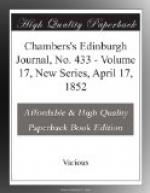In the Via dei Bardi stood, probably still stands, the house inhabited by the chief of the great and noble family from whom it takes its name—we write of the period of the fiercest struggles between the Guelfs and Ghibelines; and the Bardi were powerful partisans of the latter party. In that house dwelt a young girl of uncommon beauty, and yet more uncommon character. An old writer thus describes her: ’To look on her was enchantment; her eyes called you to love her; her smile was like heaven; if you heard her speak, you were conquered. Her whole person was a miracle of beauty, and her deportment had a certain maidenly pride, springing from a pure heart and conscious integrity.’
From the troubled scenes she had witnessed, her mind had acquired composure and courage unusual with her sex, and it was of that high stamp that is prone to admire with enthusiasm all generous and self-devoting deeds. Such a being, however apt to inspire love, was not likely to be easily won; accordingly, the crowd of lovers who at first surrounded Dianora gradually dropped off, for they gained no favour. All were received with the same bright and beautiful smile, and a gay, charming grace, which flattered no man’s vanity; so they carried their homage to other shrines where it might be more prized, though by an inferior idol. And what felt Dianora when her votaries left her? We are not told; but not long after, you might see, if you walked along the street of the Bardi towards evening, a beautiful woman sitting near a balcony: a frame of embroidery is before her; but her eyes are oftener turned to the street than to the lilies she is working. It is Dianora. But surely it is not idle curiosity that bends her noble brow so often this way, and beams in her bright, speaking eyes, and sweet, kind smile. On whom is it turned, and why does her cheek flush so quickly? A youth of graceful and manly appearance is passing her window; his name is Hyppolito: he has long cherished the image of Dianora as Dante did that of his Beatrice. In loving her, he loved more ardently everything that is good and noble in the world; he shunned folly and idleness, and strove to make himself worthy of what he believed Dianora to be. At length, one of Cupid’s emissaries—whether nurse or friend the chronicle does not tell—aided Hyppolito in meeting Dianora. One meeting succeeded another, till she gave him her heart, as such a true, young heart is given, with entire confidence, and a strength of feeling peculiar to herself. But what could they hope? Hyppolito’s family were of the opposite party, and they knew it was vain to expect from them even a patient bearing; nor were the Bardi behind in proper feelings of hatred. What was to be done? There was but one Dianora—but one Hyppolito in the world; so have many wise young people thought of each other both before and since the days of the Ghibelines; but these two might be excused for thinking so, for many who saw them were




